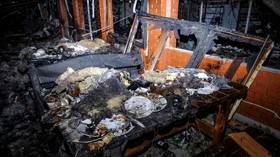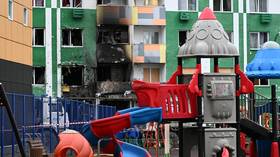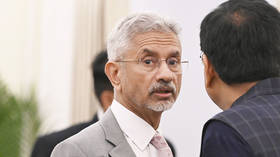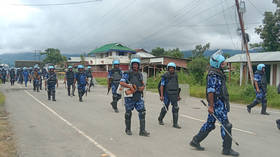Syria chem rockets ‘could have never been fired from govt controlled territory’
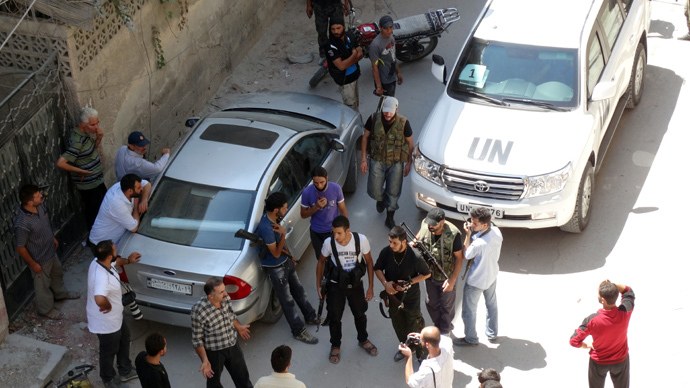
There is no way Washington could have a definite proof of who was behind the chemical attack in Ghouta because the toxic missiles could have “never” been fired from territory controlled by President Assad’s forces, co-author of the MIT report told RT.
Richard Lloyd, a former UN weapons inspector, who now works at
the Tesla Laboratories Inc., studied the White House report and
the UN report on the August 21 sarin gas attack in Syria together
with Theodore Postol, a professor at the Massachusetts Institute
of Technology (MIT).
After calculating the possible range and trajectories of the
missile used in the attack, the two men published their own
report titled “Possible Implications of
Faulty US Technical Intelligence in the Damascus Nerve Agent
Attack of August 21, 2013.”
In an interview with RT, Lloyd pointed out the inconsistencies of
the White House report and map, and of the statements of US
Secretary of State John Kerry, who claimed to have evidence of
Syrian President Bashar Assad’s forces being responsible for the
attack.
RT:You co-authored a report that suggests
the Syrian rebels could be the ones to launch a chemical attack
in Ghouta. What are the most-important facts you uncovered?
Richard Lloyd: Well, I guess let’s step back a
bit. I think the report does not specifically say that the rebels
did the attack. And to be quite frank, Dr. Ted Postol and I do
not know who did the attack.
What the report actually says is basically that the White House
had published a 4-page memo on the results of the chemical
attack. In conjunction with the memo they also published a map.
And on this map they had plotted the territories that were Syrian
government occupied relative to where the rebels occupied. And
then between those two territories they had an area called the
contested territory.
So what we did in our analysis is try to understand the range of
these types of chemical rockets. So we went through 2 to 3
months’ worth of study to determine the types of rockets, their
weight, the size of the propellant. And we determined that the
range is on the order of two kilometers. I would like to make a
note that the UN also have come up with a range of approximately
2 kilometers.
What we are trying to point out in this study, or one of the
points of several, is that when you look at a 2 kilometer launch
range relative to the White House map – it would take
approximately 6 to 7 kilometers to be launched from Syrian
government territory. So the map does not make sense to us and we
would like more explanation on exactly on what the map means.

RT:With everything you have seen can you draw any conclusions about who fired the rockets or where they were fired from?
RL: Basically, the White House maps says, it would require a launch of approximately 6-7 km to be launched from the Syrian government territory or as Secretary Kerry says, the ‘heartland’ or the heart of the territory. We know that 2 km is definitely not the heart of the territory. It is more into the rebel or contested territory.
So this is very confusing to us in our studies and what we are trying to understand exactly, what the White House map means, because right now as it stands, these rockets could have never been fired from government controlled territory. They would be fired more from a rebel type of a territory or a border of a contested territory.
RT:But the US intelligence still insists it is correct on implicating President Assad. How can they be so clear?
RL: We really do not know to be quite honest with you. There are many things in this White House report that we just basically do not understand. For example, the White House report says that the satellites are able to detect the launches, the time and when, and we believe that. We believe that these rockets can be detected by looking at the plumes.
However though, there is a concern here, you have to recall that during these chemical attacks there was also artillery fire and other rockets being fired that were high explosive. So the question we have come up is, how do you know that your satellite is actually looking at high explosive rocket launch or chemical rocket launch – you just do not know.
Another factor that we consider was that the White House map or the White House report said they know the time when these rockets actually hit the ground. This is false and the reason why, is that chemical rockets do not make explosive flashes. They hit the ground and disperse the chemical. There is no explosive flash. So we are very confused on how they can use these types of sensors to determine when they hit and the time they hit, when you cannot even see a flash.
RT:The global chemical weapons watchdog is saying that Syria now may not be able to meet the June deadline to get rid of its toxic arsenal. Why is the process falling behind schedule?
RL: Well obviously this is a very, very large endeavor, the process of delivering tons and tons of chemical weapons and materials to a ship. The problem is, obviously, I have to believe rebels would like to intercept those materials as they are being driven to the ship or to the dock, and then obviously, there is a logistic coordination that has to be conducted to actually load these materials onto the ships, ship them either to Italy or other parts of the world that are going to handle these and then transport this to an American ship, take them out to sea to destroy.
I do not think this has ever been done before, so to expect some type of delay, to me, it is expectable. From my perspective, I am more concerned about the safety of transport of these types of materials from a heartland out to a dock and not having the rebels attack them.
RT:What is your view of the final way they are going to be disposed of at sea?
RL: Well again, I do not see any problem of this at all. The techniques have been used for years, they have been used in the United States. I know there are some people who have criticized this that it has never been done, but the fact is, it is going to be out to sea, there are going to be some unknowns, but from my perspective, I think this is the best way to go.
I think from my perspective also, the real crux of all this is really transporting these materials safely to the ships to make sure that they get there without any harm to anyone during the process of the transport.
The statements, views and opinions expressed in this column are solely those of the author and do not necessarily represent those of RT.
The statements, views and opinions expressed in this column are solely those of the author and do not necessarily represent those of RT.




